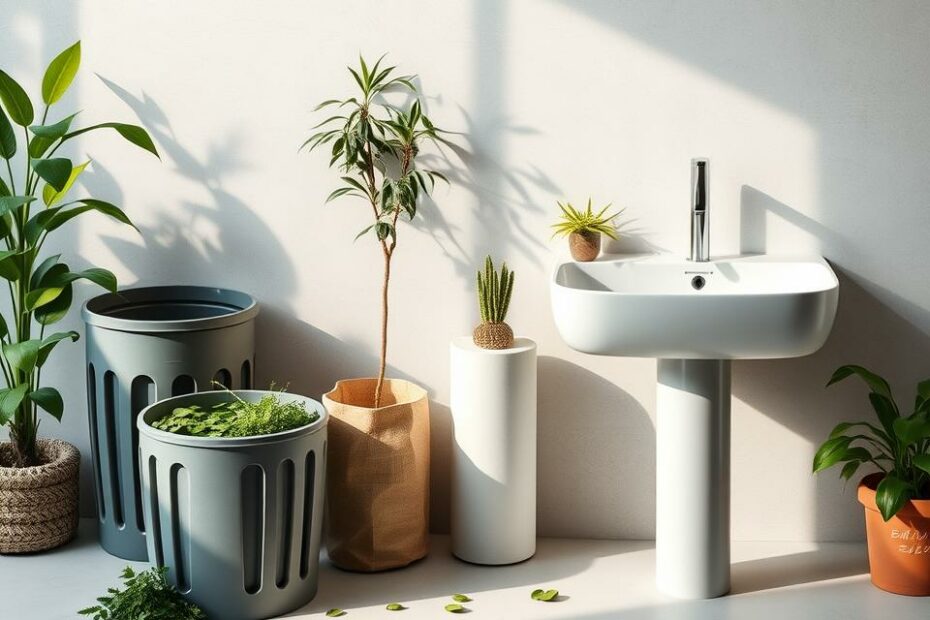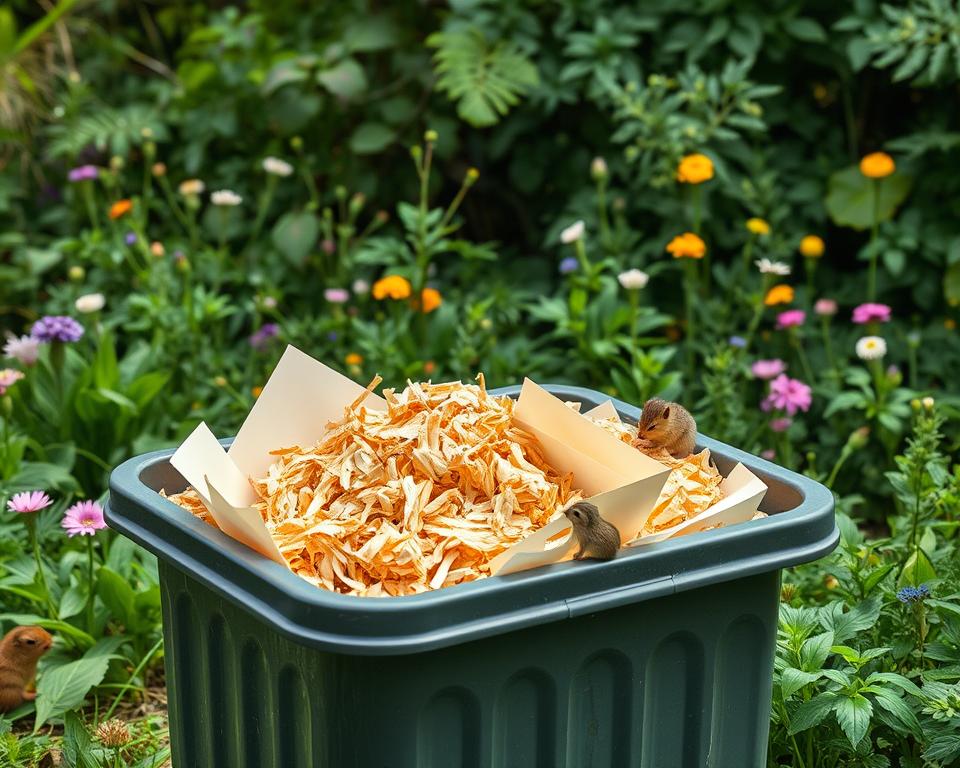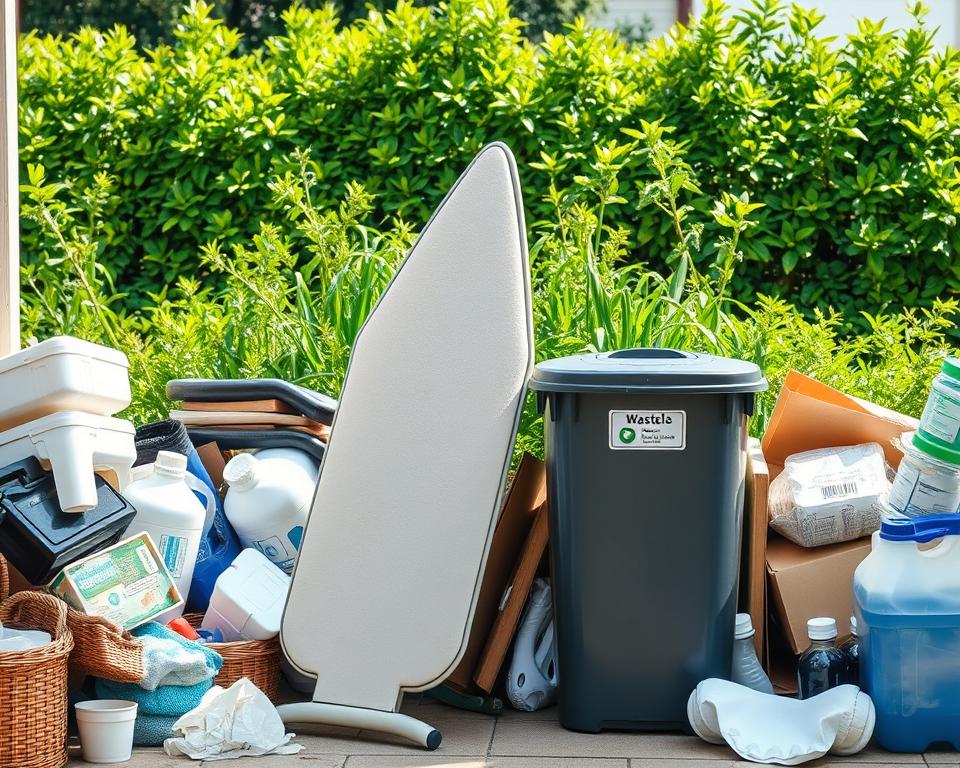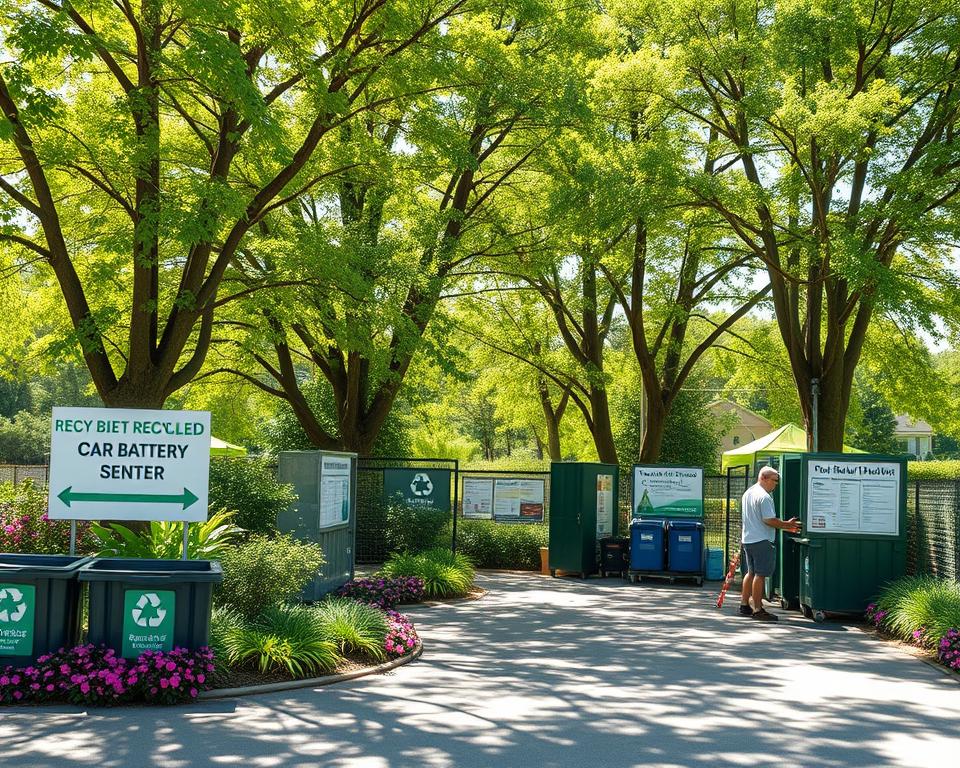Did you know that nearly 75% of all sanitary sewer overflows come from clogs? Unsaturated fats are a big reason. This shows how important it is to manage wastewater right. When we get rid of washbasins wrong, it pollutes our lakes and rivers.
Learning how to dispose of washbasins the eco-friendly way is key. It affects our homes and the planet. We’ll look at ways to dispose of sinks that are good for the earth and reduce harm.
There are many ways to recycle or upcycle your old sink. You’ll find out how to do it responsibly. Let’s explore these green practices together!
Key Takeaways
- Proper disposal of washbasins is vital in preventing environmental pollution.
- 75% of sanitary sewer overflows are caused by clogs from inappropriate waste disposal.
- Eco-friendly tips can significantly impact local ecosystems.
- Recycling and upcycling can prolong the life of bathroom fixtures.
- Understanding disposal regulations ensures more responsible waste management.
- Medications and hazardous waste require safe disposal methods to protect health and the environment.
Understanding the Importance of Proper Disposal
Proper disposal of washbasins and other bathroom items is key to keeping our environment clean and safe. If these items are not thrown away right, they can harm our planet. Broken washbasins in landfills can pollute and waste, causing harmful substances to leak into the ground and water.
Homeowners can show they care about the planet by choosing to dispose of items correctly. Not disposing of washbasins right can hurt animals and the water in our oceans. Every time we dispose of these items the right way, we help our planet stay healthy.
Many communities are now working to teach people about the right way to get rid of old fixtures. They want everyone to join in recycling efforts. Knowing how bad it is to not dispose of items right makes us think about better ways to take care of our homes.
Common Misconceptions About Waste Disposal
Many people think that “flushable” or “biodegradable” products are safe for sinks and toilets. This belief can harm the environment and cause expensive plumbing problems.
For nearly a century, garbage disposals have been around. Yet, myths about how to use them still exist. Some believe ice can sharpen disposal blades. But, disposals use grinding teeth, not sharp blades.
Some think all food can go down the disposal. But, flour can clog it. Also, soap can build up and make the disposal less effective over time.
Stickers from fruits and vegetables can jam the disposal. Foods like oatmeal, corn, and potato peels can also cause problems. Grease disposal through the disposal is harmful and can cause blockages.
It’s important to know the truth about garbage disposals. Running cold water while using it is best, as hot water can damage it. Following guidelines from trusted brands like InSinkErator helps dispose of food waste better and more eco-friendly.
Why You Shouldn’t Flush Contaminants
Flushing things like medications, oils, and chemicals is bad for the environment. It pollutes water, making it unsafe for animals and people. This can harm health and ecosystems.
Impacts on the Environment
Flushing harmful stuff has long-term effects. It can cause serious health problems, like cancer. It also harms aquatic life, leading to diseases.
It damages green spaces and waterways, hurting biodiversity. This can lead to fewer bees, which are key for pollination.
Alternatives to Flushing
There are better ways to dispose of waste. Here are some:
- Take hazardous waste to local centers.
- Learn how to safely get rid of items like paints and cleaners.
- Use third-party services for safe waste disposal.
Choosing these options helps the planet. Every little bit helps make our environment healthier.
Different Methods to Dispose of Washbasin
Getting rid of an old washbasin can be done in many ways. It’s important to focus on reducing waste. Knowing about recycling and creative uses can help us find better ways to dispose of things.
By learning how to properly dispose of a washbasin, we can help the planet. This is a great way for homeowners to make a positive impact.
Recycling Options for Old Sinks
Recycling sinks is a good way to cut down on waste. Many places have recycling programs for metal sinks. You can drop them off or put them out for curbside pickup.
Some areas even have special days for bulk trash pickup. This includes oversized items like sinks. By recycling sinks, we can reduce waste and support the circular economy.
Organizations like Habitat for Humanity might take intact sinks. Local salvage stores or non-profit groups also look for sinks to reuse. This helps our communities become more sustainable.
Upcycling Your Old Washbasin
Upcycling old sinks is a fun and green way to reuse them. You can turn sinks into garden planters or outdoor decor. This not only reduces waste but also adds character to your home.
Sharing your upcycling projects with others can inspire them. Posting about it on social media can encourage more people to think creatively about waste. It helps build a community that values sustainability.
| Method | Description | Benefits |
|---|---|---|
| Recycling | Drop-off programs for metal and porcelain sinks | Reduces landfill waste, promotes circular economy |
| Upcycling | Transforming old sinks into garden planters or decor | Extends lifespan, adds personality to spaces |
| Donation | Giving usable sinks to organizations like Habitat for Humanity | Supports community projects, avoids waste |
| Salvage | Utilizing local stores or building groups for reuse | Encourages resourcefulness, helps local economies |
Eco-Friendly Alternatives for Disposing of Old Bathroom Fixtures
Old bathroom fixtures can add a lot to landfill waste, especially if they’re made of ceramic. Choosing green ways to get rid of them helps the planet and saves resources. Small steps can make a big difference in waste management.
Donating items that still work is a smart move. Places like Habitat for Humanity ReStores take in fixtures that are still good. This way, they help others and cut down on waste.
Some areas have recycling for construction waste, including ceramic items. These programs help save raw materials. For example, Toto turns failed porcelain products into tiles. Even using crushed toilets to make oyster beds in New York City shows how materials can be reused.
For those who like DIY, old fixtures can be turned into something new. Broken tiles can become colorful mosaic art. Unused sinks can become planters or unique decorations. These ideas reduce waste and add creativity to homes.
Before you dispose of porcelain items, make sure they’re clean and free of germs. Take out any non-porcelain parts for recycling. Metal parts can be recycled or reused. Look for local recycling options for porcelain, or ask local waste departments or green renovation companies for advice.
In short, choosing green ways to get rid of old bathroom fixtures is good for the planet. Simple choices can make a big difference.
Preparing Your Washbasin for Disposal
Getting ready to remove your bathroom sink involves important steps. You need to disconnect plumbing, take out mounting hardware, and handle hazardous materials with care. Knowing how to remove your sink safely makes the process easier and reduces damage risks.
Steps for Removing the Bathroom Sink
- Gather necessary tools, such as a wrench, screwdriver, and bucket.
- Turn off the water supply to prevent leaks during removal.
- Detach the plumbing connections carefully.
- Remove the mounting hardware securing the sink to the countertop.
- Lift the sink away gently, ensuring no damage to surrounding areas.
Cleaning and Sanitizing Before Disposal
Cleaning before disposal is key for hygiene and safety. A good cleaning routine helps sanitize sink surfaces. This prevents cross-contamination when throwing away your sink. Here’s how to clean effectively:
- Clear out any items in and around the sink area.
- Use hot, soapy water to scrub the sink’s surface.
- Apply a disinfectant solution to sanitize sink areas, ensuring all germs are eliminated.
Safe disposal practices are vital for cleanliness during removal. They ensure a smooth transition to eco-friendly disposal. By following these steps, you can make the sink removal process easier and keep things clean.
Environmentally Responsible Sink Disposal Methods
Homeowners have green and community-focused ways to get rid of old washbasins. They can donate sinks to local charities or use eco-friendly waste management services. Both choices help the planet and support those in need.
Donation to Local Charities
Donating sinks gives them a new life. They can be used again or sold cheaply. Many charities welcome these donations. Here’s how to donate effectively:
- Check with local charities to see if they accept sink donations.
- Ensure the sink is in good condition and clean prior to donating.
- Ask about any specific requirements or preferred donation processes.
Donating sinks helps the environment and supports local communities. It promotes a culture of sustainability and support.
Taking Advantage of Local Waste Management Services
Many cities offer special sink disposal services. These services focus on eco-friendly disposal. They include:
- Scheduled pickups for bulk waste, including sinks.
- Drop-off facilities that specialize in accepting various materials.
- Education on proper disposal practices through outreach programs.
Using these services ensures sinks are disposed of in an eco-friendly way. Homeowners can feel good knowing their old fixtures are handled responsibly. It helps keep communities clean and sustainable.
Washbasin Disposal Tips for Homeowners
Homeowners can help the environment by knowing how to dispose of washbasins right. It’s important to find recycling facilities to keep materials out of landfills. Using eco-friendly trash bins is also key to reducing waste and promoting recycling.
Where to Find Recycling Facilities
Finding local recycling facilities is crucial for sink recycling. Websites like Earth911 or your city’s waste management site can help. They list places where you can recycle old sinks and other items. Using these facilities supports sustainable waste management.
Best Practices for Eco-Friendly Trash Bins
Using eco-friendly trash bins the right way can make a big difference. Here are some tips:
- Sort recyclables by separating plastics, metals, and papers.
- Compost organic waste when you can.
- Learn about local disposal rules to follow them.
- Don’t put non-recyclables in trash bins to avoid contamination.
Following these tips helps reduce waste and promotes recycling in your community. Homeowners’ efforts are crucial for eco-friendly disposal and sustainable waste management.
| Recycling Facility | Types of Accepted Items | Location |
|---|---|---|
| Habitat for Humanity ReStore | Sinks, toilets, appliances | Various locations |
| Local Recycling Center | Porcelain sinks and toilets | Specific town or city site |
| Municipal Waste Management Drop-off | Construction materials | Designated depot |
Understanding Local Regulations on Disposal
It’s crucial for homeowners to know the rules for getting rid of old sinks and bathroom items. Each state has its own laws about how to throw away these items. These laws help protect the environment and manage waste properly. Breaking these laws can lead to fines, so it’s important to stay informed.
Researching Local Rules on Sink Disposal
Local sink rules cover what can and can’t go down drains. Homeowners need to know these rules to avoid legal trouble. There are also limits on how much certain materials can be thrown away.
Some chemicals, like copper and zinc, have special limits for disposal. For example, aliphatic diamines with six or fewer carbon atoms can only be disposed of in small amounts. Materials like ethers and halogenated hydrocarbons are considered hazardous and must be disposed of carefully.
In many places, big gas tanks must go back to suppliers, while small ones can be taken to Household Hazardous Waste facilities. Metal appliances can be recycled at local waste management sites. Recycling aluminum cans is also encouraged at curbside and recycling centers. Knowing these rules helps homeowners do their part for the environment.
How to Get Rid of Sink in Sustainable Ways
Looking for ways to dispose of sinks that are good for the planet is smart. There are many sink disposal methods that are kind to our environment. Donating working sinks to places like Habitat for Humanity is a great idea. They use these items to help build homes for those in need.
Recycling sinks and their parts is also key. Many recycling centers take metal pipes and faucets. By recycling, we save resources and cut down on landfill waste.
Using greywater systems is another smart choice. Greywater comes from kitchen sinks and can water plants. This saves water and helps plants grow, even in dry times. It’s important to use plant-friendly soaps to protect soil and plants.
Lastly, upcycling is a creative way to reuse old plumbing parts. Turning faucets into hooks or shelves is a fun way to reduce waste. It’s good for the planet and lets you express yourself through your home.
Conclusion
To make a real difference for our planet, using eco-friendly sink disposal is key. This article has shown us many ways to recycle and upcycle old washbasins. These methods not only cut down on waste but also teach us to care for our environment.
By using these methods in our home renovations, we help the planet. Every small action we take can make a big difference. Choosing eco-friendly disposal methods can positively impact our community and the world.
Adopting these green practices is not only good for the planet but also empowering for us. Every step we take towards sustainable disposal helps save our resources. It ensures a cleaner future for all of us.
FAQ
What is the best way to dispose of a washbasin?
Recycling your washbasin is the best option. You can donate it to charities or use eco-friendly waste management services. Local recycling programs also accept it.
Can I flush my old sink down the toilet?
No, it’s not safe or good for the environment. Flushing an old sink can cause big blockages and pollute water systems.
How can I upcycle my old washbasin?
You can turn it into a garden planter or outdoor decor. It can even become a pet bed. Upcycling adds charm and extends its life.
What contaminants should I avoid flushing?
Don’t flush medications, chemicals, or food. They can pollute water and harm fish and other sea creatures.
Are there local charities that accept functional sinks?
Yes, many charities accept sinks for resale or reuse. Look for organizations in your area that help with home improvement or support those in need.
How do I prepare my washbasin for disposal?
First, disconnect the plumbing and remove mounting hardware. Then, clean and sanitize it. This makes it ready for recycling or donation.
What should I do with hazardous waste?
Take hazardous waste to local centers or special events. They handle it safely, protecting the environment.
Where can I find recycling facilities for old sinks?
Check Earth911 or your local waste management website. They list recycling facilities near you.
What are some eco-friendly practices for trash disposal?
Sort recyclables properly and compost when you can. Follow local guidelines to reduce landfill waste.
Are there regulations on disposing of bathroom fixtures?
Yes, each state has laws for disposing of bathroom fixtures. Knowing these laws helps avoid penalties and ensures compliance.





